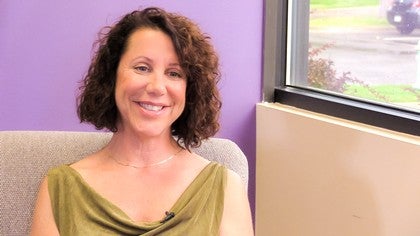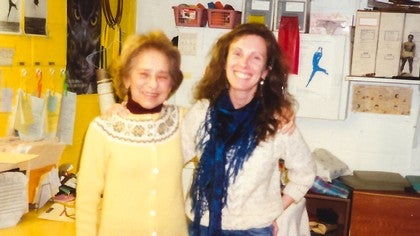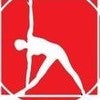Description
About This Video
Transcript
Read Full Transcript
So my name is Kim Hiroshi and I was trained by Kathy grant back in the Bendel's era. And um, I currently have a private practice where I combined [inaudible] with craniosacral therapy, trauma therapy and body centered psychotherapy. And I teach workshops to pull out these professionals. I met Cathy, I don't remember what year it was, but I think it was the late seventies. I was on scholarship with the Alvin Ailey dance company and I had hurt my knee continuously. So whenever a dancer got injured, they sent them to Kathy grant. So I was sent to Kathy Grant. I actually had gone to an orthopedic surgeon who as a surgeon would want to do, wanting to cut and they said, no, no, you go see Kathy ground first.
So I went into Bendel's and um, she was not there my first day. She came in later, um, her assistant Jackie Sawyer was there. So she was teaching me some very basic warmups, um, how to use your stomach, how to breathe, how to flex your hips, you know, knee folds, very basic stuff. And then I left and the next day I came back in and Jackie was there and started the warmups and then came Cathy grant. And I remember she looked down at me and she went [inaudible] that in it.
And I didn't know what it was. I didn't know anything about that. And she sat down and she put her hand on my hip flexor and she taught me to breathe. And, um, the touch that she had relayed to me how to use my body. She had a little studio on the sixth floor of Henri Bendel's department store. It was behind John The weed Davide hairdressing salon. So you took the elevators up and you went through this hairdressing salon, you know, and this was the late seventies.
So disco people were getting funky. People were, God knows what people were doing there, but it was quite a scene that you walked through. And, um, then you came into the back and there was this silence and, and, um, this depth was occurring and it was this tiny little room. It was a tiny little room and you had two showers, none of which were working. I mean she didn't use them and one was used for changing or maybe that was a little changing room and then there was a shower next door with all her cleaning stuff in it and that's where you got your towels from because she always had to take a towel to put under your head when you went down to work and um, you would go in. So, uh, anyways, so my first day I worked with her assistant, I believe, and it was the second day that she came in cause she had an appointment or something. So the assistant started me. But the second day she came in and I didn't just learn how to breathe and how to do a movement. There was particular very particular alignment she was wanting and particular muscles to fire. She didn't know anything about anatomy. Neither did I.
I didn't know any of it at the time that she didn't know anatomy. But she would say, no, not that this, not that this, this, she could foresee before you moved, she could see the intention and she'd stop you before you made the movement, before you ingrained that pattern, before you fired those neurons. She stopped it. I thought she had x-ray vision, you know, she, she could see anything. And I, I didn't get it. I mean, I thought I knew what I was doing. My Body, I was a dancer, but I did not understand the depth of how to work with my body. And, um, she knew things about me that I never told her because she could just see who I was. So she would relate to me that way. So she was somewhat, um, awe inspiring in that way. And she was very strict. But when it came to the Rehab, she'd be very kind, unless she needed you to get something that you couldn't get, you know, and she would, um, require this depth of mindfulness.
There was no room for anything else. But this one pointed mindfulness as you were doing an exercise and that's what was required to be able to fire those particular muscles to get that particular alignment that your knee or your hip or your ankle, whatever it was, would start to heal. So when I first came to her, um, she, uh, said, so they think you need a knee operation. And I said, well, that's what the doctor told me. He said, I need a knee operation. And, and in those days it wasn't the drive through ACL lap, uh, author of scopic surgery. It was a big deal. And you were in the hospital for a while. And I had a friend who had had it done. It was quite a big deal and it ended her career actually.
So no one wanted surgery. So Kathy, um, put me up on the barrel and you know, as a knee person, you had Mr PyLadies silver weighted as the lead weighted shoes. So these led weighted shoes on the bottom and then it had this canvas top and then they laced around like ballet, toe shoes, you know, so you had those plus ankle weights. Okay. And I'm like 96 pounds maybe, you know, and I had all these weights on me and then you get on the barrel and she hung this other, in those days it'd be this round weight with a hole in it, you know, it was like 10 pounds. I don't know how long much it was, but it was a lot. And a towel went through it and she attached that to my leg and she would have me straighten my leg and release and she would listen to the knee. You know, she would literally listen with her ear. But before she even did that, she watched me try to straighten my leg and she went, you don't need no operation. You need some quads and you need some abs.
And she punched me in the stomach. And that's when I learned to really pull my stomach. So we continued to that exercise. And um, you know, we did a little that day and that was part of my rehab. And I remember then she started demanding more and more of it and it was getting harder and harder and I was sweating and I started crying and she would just yell at me, you wanna dance, you wanna dance, you wanna dance. And it was like she was challenging me and it wasn't so much that, um, for me the response wasn't so much, Oh, I want a dance. I'm going to do this.
It was more like, you're challenging me. Okay, I'm going to meet the challenge and I will do this. I will defy you. And she knew that I had that kind of a character structure. So she got to my personality that way. When Cathy asked me to take over her gym, which is what she called it, the gym, um, it was one of the more terrifying phone calls of my young life. Not only because it was such a responsibility, but Kathy's Day would start at 6:00 AM if one of the dance theatre of Harlem dancers needed to be stretched. If not, maybe it would start at seven and she would go until five or six at night.
And I didn't think I could even handle it, you know. Um, so she said, no, I'll get other people in to help you. You know, you won't have to do a full day. Um, but Cathy was called to, uh, choreograph or assist in choreographing the cotton club, the film. And she so wanted to do this, she so wanted to do this. And she said, you know, this is gonna be three weeks, four weeks, maybe five weeks, you know, but I'm asking you, and, and, and I, and, and if I, if you can't do this and I can't do the film, and I could never say no to Kathy. I could never say no to Kathy. And so of course I said yes. And, um, I saw on Kathy and that Iro, you know, I would see her, we would, you know, of course, see each other at times she came alive in a way that I did not know her.
I never knew her as a dancer, you know, so she would come back from the set and she'd be like, look what we did today. And she'd show me what they did. And, well, he wanted to do it this way, but I did it that way and the dancers liked it this way and then we cut it this way and the two of us figured this out and it was beautiful, you know? And she, she did most of the choreography as far as I recall. And she just came alive in a way that I hadn't seen her and we would go out for drinks after work. So sometimes she would come over after the set and we'd go for drinks and she was just transported, you know, she had taken a break from her routine of giving so much to everybody in such a very deep particular way, which was so consuming, more so than I ever realized. It wasn't until I started teaching Palladio's professionally all the time that I realized, oh my God, what was she doing? You know?
And that Rehab. So that's what it was. I think for Kathy, it was really, um, a window back to a life that she had loved so dearly. You know, it was interesting taking over the gym. It was, it was really interesting. There were so many different kinds of clients that were there. And Kathy with her schedule, she, um, arranged her schedule. It was all orchestrated. You just didn't get an appointment because you asked for one, you got an appointment because she would see the dancers at this hour.
In the early morning, she'd see the dancers cause they had rehearsals or they had scholarship classes or she didn't want them out late partying. Um, so she, she would arrange it that way in the afternoon. Well this one doesn't really get along with that one, so I'm going to schedule them at different times, or this one needs more of my attention or this one's fine so she can come in whenever she wants to come. So I started seeing that there was this whole inner workings of Kathy's gym that I never knew about. So she pretty much took care of the scheduling and, um, you know, I would take care of cancellations and maybe moving some people around, but I knew what the parameters were. And, um, one day, uh, one of the things that she had said to me with some of the clients, she would get all different kinds of clients up in her gym and um, she would get all, you know, young dancers, famous dancers, black dancers, white dancers, all different kinds. And they were all treated the same. It didn't matter. It didn't matter how famous you are or how unfamous you were, she treated everybody the same and she believed in everybody so deeply. But if you didn't take her seriously, then you could lose her belief.
And then it was a different relationship, which I saw once I started working for her. And um, she had said to me a very famous singer was coming up, so she had singers as well as dancers, as well as regular people. And um, a very famous singer was coming early in the morning and she didn't want anyone knowing she was there. And Kathy said to me, I said, listen, when Ms [inaudible] comes up here, ms thing may think she's somebody outside of the gym, but here she's just so and so. So you just treat her like everybody else. You don't give her any more attention. You help her, like you help everybody else. But if she needs to wake, then she waits. And that's how she was. Kathy was never impressed by people's exterior personality or what they had gained in their lives. She was impressed by someone's integrity and what their character was and their genuineness. That was my impression of her at least. So one day, um, when I was working for at the gym Fridays was the day we had a hand money into Bendel's. Right? So that was a big day. And um, she would try, if she could to come back to make sure I wasn't messing up the books. Right.
So the gyms be there, a couple of people in the gym and I'm at, you come into the gym and there was a little tiny little desk area and little file cards. Everybody had their own file cards and they had all their exercises on it. So they had to know what their prompts were and that was there. So her appointment book was there and we kept the money in a particular secret place, which I think I'll still keep seeing. And I'm, I'm counting the money and figuring out what goes to Bendels or whatever the, whatever the routine was. And I had to do, Kathy comes in and I'm working with the money and she said he's not doing that right. And I said, what? She goes, he's not doing short span. Right? And so I turned around to see what he was doing. She goes, you can't turn your back on the money. So I turned back to the money. She goes, he's still not doing it right now. Talk about a double bind. Right?
It's like either way I'm going to lose. And she said to me, how do you have to learn to listen to the springs? You have to listen to the springs. You have to see from behind. To be taught to teach by Kathy. Grant was nothing like what goes on today. You know, I worked at the Palladia Center for years, teaching their teacher training program and um, being taught by Cathy was completely different. There was no format, there were no rules, there was no guidance, there was no obser, but there was, there was nothing. There were, there was no, um, it was all free fall. So I was, um, a client of hers, but then she would say, come here honey, and hold this hip. Come here honey, and hold this ankle and go teach him the knee lifts.
Go teach her how to lift, how to float the leg off the wall with 50 pounds on the end of her ankle. She would just start sending me around. And I guess I didn't realize it at the time, but I guess she was watching me and felt this was something that was worth spending a little time on me being the [inaudible]. So it started like that. And then she would sometimes put my hand on something, she'd be like, no, not like that. Like this. And she would put her hand on my hand and show me how to hold a hip in place so that she could do the side leg springs, which she had a very particular way of doing it. It's not the traditional way.
And, um, then she would often tell the client to breathe down the leg and I would feel the femur release from the hip socket and was like, oh. And then I started noticing, oh my God, that client's spine is changing and her neck is changing. And, and I could see, I could start tracking the entire body. So I learned that way. And basically when I would teach someone, um, if she didn't say anything, then it was all right. And if it wasn't, I knew about it. Sometimes she would be nice and sometimes she wasn't. The main thing with Cathy was, is that she always taught the person she never taught and exercise. She always taught the person.
So one time I was teaching a man the teaser, and he was going up, but his ribs kept opening. So I was trying to get him to bring his ribs in and I was teaching an exercise to a body. She went off on me, off on me, and we went out to dinner that night. She kept going off on me. She never stopped. I mean, it was out. It was relentless, really. But she wanted to make sure that I got it, that I missed seeing who this man was and that that kind of a correction was actually going to be upsetting to him. And that he had had asthma and I could have seen that had I seen his ribs and had I seen his, his personality, his character. You know, and I never made that mistake again. So that was a huge learning curve.
You know, Kathy never every like a hundred, you know, where's your head in hundreds? That's the big question these days. Or what's the Tuck or where's your tailbone or where do you pull your hips in? And Kathy never had an answer for that. She would teach me to look at the body and look at the person. Right. Well this person's really stressed.
So their heads out like this all day long cause they're working on legal stuff. So are you gonna tell them to bring their head back? No, that's going to stress them more. So she would find a prop to give them a ball under their chin maybe. So when they rolled up there would be a ball there. And so the person didn't have to stress about a correction.
She always looked individually, not only at the body, but at the whole person's life. You know, her ladies who would come into the gym, she, she loved her ladies, you know, and she, I always thought she was nicer to them than to us cause she was so much more stricter with dancers. Um, but she loved her ladies and she would say to me as her assistant, this one's having some trouble at home. So go easy on her. You know, this one's a, has a lot going on at work, so she needs to focus. So I want you to really go in there and make sure she does this right. You know, so she would really see what was happening in people's lives and then adjust the teaching of the day to that person. So it was incredibly unique. The other main thing that Kathy taught me about teaching this was huge was you have to teach rhythm first. Don't teach an exercise. You have to teach your rhythm first and they have to find their own personal rhythm, right? So someone come in, lie on the reformer for footwork and I, and I teach this all the time to people. You just put your foot up, you put your feet up and then you get used to the springs and the carriage moving. You just go in and out, you know, and they're moving kind of like this.
Their 10 said first, but then they start finding a flow and it's their flow. It's their rhythm. Then you start adding the breath, then maybe you'll bring the foot into whatever position is most comfortable for them. Not Necessarily Mr Piles v to start. She would always respect his order, but she taught with rhythm and um, and with fun, with lot of fun. You know, she would be very intense with her rehab and strict and, and unforgiving so that we could get better. But um, she would do crazy things like with knee stretches. At the end of my workouts, there were like two hours or two and a half hours. Right. That was a normal workout. The end of that, she'd be like, now you have to, your hundred knee stretches. So it'd be Stan. I'd be doing standing knee stretches of the magic circle between my knees and maybe between my ankles at the same time, be there two or one, 100 of them. And I could not leave the gym until I did that. Right. So, and I was just not the only one. All of us had these knee stretches.
So then she decided she was gonna make up knee stretch Olympics. So we all had to do these knee stretches and we want to see who would get to the most. And one of the dancers want it 250 so she would also, another brilliant about her work was she would come up with images of the time, right? So when I learned the cat, which was the first original cat, which is different than the cats now you were just on four legs and you were going through flection and articulation of the spine. She would put her fingers on my spine and say, walk your fingers through the yellow pages, because that was a commercial at the time. Right. So then she wanted us to learn how to really pull in the low abs. How to really work the transverse. And so she would say, come on, put on those mckeen jeans, zip up those jeans.
And then those days McCain jeans were really famous and they were these totally tight snatched jeans from France and you knew if the size was right, if in the McCain gene store you lie down on a bed, which they had there and the salesperson had to zip you up, if you could zip it up yourself, those were too big. So she would say put on those jeans. So that's where the zip up came from. It came from the era of McKean jeans. What I didn't realize then, but now that I've done some studying is I don't think Kathy knew about the nervous system per se, but she understood it, right? I mean the more recent discoveries is, is the triune nervous system that there's actually three parts, not just parasympathetic and sympathetic, but Cathy always engaged the social nervous system and she knew if you were hyper, how to bring you down if you were to Hypo, how to bring you up. So she knew how to work with the nervous system. And years later, I find myself lot of my work based on nervous system work and now I'm creating a training on bringing nervous system work into Palladio's and with her touch and feeling and being able to see through a body. I, when I leave years, decades later when I went to cranial school, that's one of the things you have to learn is how to listen with your hands. And it came quite naturally to me and I think it was because of Kathy, I think it was because of how she taught me to teach.
Take the time to know your body, understand how to fire ABS, understand how not to roll your shoulder forward, understand the mechanics, but then go, do PyLadies be free, go do PyLadies, move, move, find your rhythm and move. And she said that's what Joe wanted anyway, you know, so, so the quality of just moving and allowing [inaudible] to do you. And I think that was Kathy's perhaps greatest gift that she passed on when I first started learning to teach with her. As I said, it was just assisting her and then it was being taught. And then it was, can you run my gym? Right. But the main thing that Kathy would always say to me is they've got one body don't hurt them. And that's how I learned not to injure somebody. It wasn't, oh, make sure the arm isn't turned backwards or that the, the, the foot bar is down or the hell no, it was, they've got one body don't hurt them. So I had to know the exercises hers as well as Mr [inaudible] and the person's body. Well enough to know. It wasn't a bunch of rules for me, you know, I mean headpiece down on spine lift. Sure. But um, most of it was not rules like that.
And then she incorporated so much else into her work. So there were Cathy grant exercises. I had to know those than those, these came from eve. These came from California, which I think meant Ron Fletcher. Right. These came from Corolla and this is Mr [inaudible]. And it was really important to her that I would differentiate and not mix things up. And so that each lineage had their credit do, each teacher had their credit due and she took from everybody, you know, the California people would come in and I would go to correct their rowing's and she would say, no, she'd stopped me. And she goes, there's something you can learn from everybody. Let's see what they're doing. And so we'd watch it. They were doing, and then she was like, I like that.
Next thing you know, she either incorporated it or part of it into her workout or took a snippet of it and made it a pre rowing. Like she made a pre spinal pretty short spinal. So that was a big piece. And um, she also said, never let anyone get dependent on you. Never let anyone get dependent on you. Don't be someone's guru. So I remember with my knee when I would hurt my knee, she would say, me, what are you going to do when I'm not around anymore? What are you going to do when you're on a desert island? And, um, years later I had moved to the Caribbean.
I was on an island and I'd hurt my knee and I was damned if I was going to call. So I pulled together my rehab without Pele's equipment, but, um, was sand and I made my little wait and I use flippers in the ocean and in a pool and I'd recreated her work out of what I had on the island and I rehabbed my knee. And then I called her and she was so happy, you know, so happy because she felt like that was a lesson she wanted all of us to learn. So then she had this exercise, um, rib cage arms. And although she did it in class at NYU, I think it's very different what it was one-on-one with her. And so, and she taught me how to teach this one, which was really, it was phenomenal exercise. And, um, it really led into a lot of what my work has become today, which I can talk about a little bit later, but you would lie on the ground and she would put her hands under your back and you would feel what part of your back was up, right? And then you'd breathe into it.
You breathe into it until it started relaxing down, relaxing down, relaxing down. And this could take 10 or 15 minutes of just breath, maybe five, then she would add the pole and the full exercise of ribcage, arms. But, um, it's so slow do down and it brought you into this profound level of mindfulness awareness, right? So, you know, these days mindfulness is all the rage, but Kathy was practicing that with us years and years ago. You know, and Polonius was based really on mindfulness in many ways. But I think she took it a deeper step. So one day I had met her for dinner after work and she said to me, you won't believe what happened today. And I said, well, what? She said, I was teaching someone ribcage arms. And that woman said to me, I touched her soul, I touched her soul, Kim, I touched her soul. That's what she kept saying over and over again all night. She would say that. And I was just looking at her like, you don't know that, that that's what you do all the time. That's what you do. That's what you do. And then the other thing she would say to me and um, and she actually, she said it to me then and um, and she said it to me when she was dying, when she said, um, you hold the essence of my work. You have that, but don't imitate me. Don't ever imitate me. And I said to her, Kathy, I never tried to imitate you. But sometimes when I'm teaching, particularly if I'm doing rehab, you come out of me cause I can't help it.
You know, she had a brilliance of you were about to fire them wrong. No, don't do that. And now having studied a little bit more about the brain, I realized yet she was actually bypassing the prefrontal cortex and going more into the midbrain. So you were going more into a direct response and your body was going to respond that way. It was going to respond more reptilian. So you weren't thinking about how to correct this. It was no, don't do that. And you stopped before you created another neuro pattern and northern neuropathway so little times like that, things like that will come out of me, you know? Um, she'd walk by, you'd be doing the hundreds and she'd look down at you and say, what's that supposed to be? And walk on. And that was the correction and you'd have to figure it out.
You'd have to figure it out and then she'd come over and help you, you know? So those were important things about, um, things that she passed on. I think so I first met Kara Reeser. I had come to boulder, I was living in the Caribbean, right. I was living in the Caribbean. I came back to, um, boulder because I was, uh, doing a 90 day Buddhist retreat. And then I came back to boulder after that and my knees were bothering me.
And so I said, alright, I gotta do some plays here. So that week it happened to have been in the daily camera and article on Palladia studios in town. So I'm flipping through them and none of them are talking to me. And then one did and it was the Palati Center. So I said, okay, I'm going to go over there. So I called up, made an appointment, by chance I'm put into Cara Reesers schedule. So I go in to take a lesson with Kara and there were all these trainees watching, which was totally new to me, and it was a big studio.
And I didn't know any of this. It was a whole new world to me. I came from Kathy's and um, you know, I've been on 90 day retreat, so I was out of shape. And so cat Karen named that to the trainees and she said, see this one, she's out of shape, but she's been trained by a master who trained you. And I said, Kathy Grant. And Karen went, Oh my God, Kathy Grant. And that was it. And so Kara and I, um, became sisters at that point. Actually, and, uh, yeah. And then Carrie said, you should really work here. And I did. And then we held Cathy grant's lineage together and, um, Amy and Rachel's studio. Yeah.
And then we went through all of Cathy's illnesses together and yeah, we supported each other through a lot of difficult times and the whole changing of the industry because that wasn't what [inaudible] was, you know, Polonius was Pleiades and it was just pull out these four Palladio's it wasn't this big industry and people doing Caladrius type type butts or, I mean, it happened of course, but that wasn't it. And it wasn't about, um, all this bunny. I mean, now potties is so expensive. It was just simpler. It was just simpler. And, and so Karen, I held, held that together.
Pilates Legacy Project: Discussions
Comments
You need to be a subscriber to post a comment.
Please Log In or Create an Account to start your free trial.























